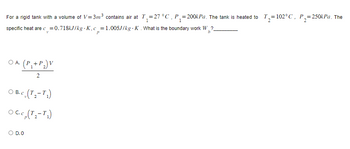
Elements Of Electromagnetics
7th Edition
ISBN: 9780190698614
Author: Sadiku, Matthew N. O.
Publisher: Oxford University Press
expand_more
expand_more
format_list_bulleted
Question
For a rigid tank with a volume of contains air at , . The tank is heated to , . The specific heat are , . What is the boundary work ?_________
| A. |
|
|
| B. |
|
|
| C. |
|
|
| D. |
0 |

Transcribed Image Text:**Problem Statement:**
For a rigid tank with a volume of \( V = 3 \, \text{m}^3 \), containing air at \( T_1 = 27^\circ \text{C} \) and \( P_1 = 200 \, \text{kPa} \), the tank is heated to \( T_2 = 102^\circ \text{C} \) and \( P_2 = 250 \, \text{kPa} \). The specific heat values are \( c_v = 0.718 \, \text{kJ/kg} \cdot \text{K} \) and \( c_p = 1.005 \, \text{kJ/kg} \cdot \text{K} \). What is the boundary work \( W_b \)?
**Options:**
- **A:** \( \frac{(P_1 + P_2)V}{2} \)
- **B:** \( c_v(T_2 - T_1) \)
- **C:** \( c_p(T_2 - T_1) \)
- **D:** 0
**Explanation:**
The problem is asking for the boundary work \( W_b \) done by the system when the air inside the rigid tank is heated. The given options offer different formulas to calculate this work based on the provided parameters.
- **Option A** suggests using the average pressure multiplied by the volume for the work done.
- **Option B** considers the change in internal energy using specific heat at constant volume.
- **Option C** involves the change in enthalpy using specific heat at constant pressure.
- **Option D** suggests that no boundary work is done.
**Analysis of the Rigid Tank System:**
In a rigid tank, the volume does not change during the process. Therefore, the boundary work done in such a system is typically zero, since boundary work \( W_b = P \Delta V \), and \( \Delta V = 0 \).
**Conclusion:**
The correct answer is **D: 0**, as no boundary work is performed in a rigid tank process.
Expert Solution
arrow_forward
Step 1
Step by stepSolved in 2 steps

Knowledge Booster
Learn more about
Need a deep-dive on the concept behind this application? Look no further. Learn more about this topic, mechanical-engineering and related others by exploring similar questions and additional content below.Similar questions
- solve Correctly urgent.arrow_forwardDo not give answer in image and hand writingarrow_forwardA constant-pressure piston/cylinder assembly con- tains 0.2 kg of water as saturated vapor at 400 kPa. It is now cooled so that the water occupies half of the original volume. Find the work and heat trans- fer for the process.arrow_forward
arrow_back_ios
arrow_forward_ios
Recommended textbooks for you
 Elements Of ElectromagneticsMechanical EngineeringISBN:9780190698614Author:Sadiku, Matthew N. O.Publisher:Oxford University Press
Elements Of ElectromagneticsMechanical EngineeringISBN:9780190698614Author:Sadiku, Matthew N. O.Publisher:Oxford University Press Mechanics of Materials (10th Edition)Mechanical EngineeringISBN:9780134319650Author:Russell C. HibbelerPublisher:PEARSON
Mechanics of Materials (10th Edition)Mechanical EngineeringISBN:9780134319650Author:Russell C. HibbelerPublisher:PEARSON Thermodynamics: An Engineering ApproachMechanical EngineeringISBN:9781259822674Author:Yunus A. Cengel Dr., Michael A. BolesPublisher:McGraw-Hill Education
Thermodynamics: An Engineering ApproachMechanical EngineeringISBN:9781259822674Author:Yunus A. Cengel Dr., Michael A. BolesPublisher:McGraw-Hill Education Control Systems EngineeringMechanical EngineeringISBN:9781118170519Author:Norman S. NisePublisher:WILEY
Control Systems EngineeringMechanical EngineeringISBN:9781118170519Author:Norman S. NisePublisher:WILEY Mechanics of Materials (MindTap Course List)Mechanical EngineeringISBN:9781337093347Author:Barry J. Goodno, James M. GerePublisher:Cengage Learning
Mechanics of Materials (MindTap Course List)Mechanical EngineeringISBN:9781337093347Author:Barry J. Goodno, James M. GerePublisher:Cengage Learning Engineering Mechanics: StaticsMechanical EngineeringISBN:9781118807330Author:James L. Meriam, L. G. Kraige, J. N. BoltonPublisher:WILEY
Engineering Mechanics: StaticsMechanical EngineeringISBN:9781118807330Author:James L. Meriam, L. G. Kraige, J. N. BoltonPublisher:WILEY

Elements Of Electromagnetics
Mechanical Engineering
ISBN:9780190698614
Author:Sadiku, Matthew N. O.
Publisher:Oxford University Press

Mechanics of Materials (10th Edition)
Mechanical Engineering
ISBN:9780134319650
Author:Russell C. Hibbeler
Publisher:PEARSON

Thermodynamics: An Engineering Approach
Mechanical Engineering
ISBN:9781259822674
Author:Yunus A. Cengel Dr., Michael A. Boles
Publisher:McGraw-Hill Education

Control Systems Engineering
Mechanical Engineering
ISBN:9781118170519
Author:Norman S. Nise
Publisher:WILEY

Mechanics of Materials (MindTap Course List)
Mechanical Engineering
ISBN:9781337093347
Author:Barry J. Goodno, James M. Gere
Publisher:Cengage Learning

Engineering Mechanics: Statics
Mechanical Engineering
ISBN:9781118807330
Author:James L. Meriam, L. G. Kraige, J. N. Bolton
Publisher:WILEY